Norwood
Home for
Jewish Children
Jewish Children
Knight's Hill, West Norwood, SE27
Medical
dates:
Medical
character:
Orphanage
In 1795 the financiers Abraham
and Benjamin Goldsmid invited subscriptions from their friends for the
foundation of a Jews' Hospital to provide relief for the aged poor and
an education for the children of poor families.
In two years the brothers had raised £20,000 and, after several years of difficulty with government bureaucracy, they were finally permitted to use the funds to establish the hospital.
A building in Mile End Road was purchased for £3,300 and the Jews' Hospital finally opened on 28th June 1807. It was known as Neveh Zedek (Abode of Righteousness).
Not a hospital in the modern sense, the Jews' Hospital was a charitable institution whose aim was to "uplift the morals and occupations of the young poor" and to protect them from having to attend conversionist and Christian free schools. The largest part of the building housed a trade boarding school for children of respectable poor Jewish families, which initially had places for 10 boys and 8 girls. The remaining part of the premises provided a home for the elderly.
In 1815, following the deaths of the Goldsmid brothers, the Duke of Sussex (Queen Victoria's uncle) became the Hospital's first royal patron.
By 1840 the Hospital contained 43 boys and 15 girls, and 12 elderly inmates. The boys received a school education and were, in addition, taught trades. Some were employed in making chairs, some in cabinet work and other in making ladies shoes. Lessons in silk hand-loom weaving had been attempted, but soon abandoned.
Ten years later the Hospital had been greatly enlarged and contained 55 boys and 20 girls, and 12 aged persons.
In 1860 the Hospital accommodated 100 boys and 40 girls, who were greatly overcrowded in the dilapidated buildings. Plans were made to move the institution to the country, and this was enabled by Barnet and Isabella Meyers, who presented the Hospital Trustees who some 9 acres of land between Knight's Hill and Canterbury Grove in West Norwood.
On 6th June 1861 Sir Anthony de Rothschild laid the foundation stone for the new Hospital building which would accommodate 220 children.
The new Hospital opened in 1863. It had cost £23,000 to build, as considerable excavations had been necessary because of the slope of the land. The entrance gate on the west side of Knight's Hill was a gift of Henry Keeling, the Hospital's Treasurer. A 2-storey Porter's Lodge was built for £323 and some £650 was spent on laying out and draining the grounds, and building new roads.
The building resembled a large Jacobean mansion. Built of red brick, with diaper patterns of black brick, it had three storeys and an attic storey set in the slated mansard roof. The window surrounds and corner quoins were of Portland cement. The entrance hall was accessed via a central projecting arcaded porch (above which was a synagogue). On either side of the central section were the north and south wings.
In 1874 the Hospital was extended.
The 1876 the Hospital merged with the Jews' Orphan Asylum, which had initially been established in 1831 at No. 69 Leman Street, Whitechapel, for the children of Mr and Mrs Noah Assenheim, who had both died during the 1830 cholera outbreak. By 1838 the Asylum housed 10 boys and 10 girls. In 1846 it moved to larger premises built for 40 orphans in St Mark's Street, on the corner of Tenter Street North and Tenter Street East (part of the Tenter Ground) in Goodman's Fields. It was later enlarged to accommodate 61 children. Following its amalgamation with the Hospital, the Asylum moved to the Norwood site, which was then renamed the Jews' Hospital and Orphan Asylum.
The institution house 159 children, not all of whom were orphans. Some came from families who were too poor to provide for them or who were unable to look after them, for example, if the mother had died.
By 1888 the Hospital accommodated 260 children and could accept no more admissions. Plans were made to extend the building again.
The new extensions - a Centenary Hall and two wings to the west of the ogee-capped tower, were officially opened by the Duke of Cambridge on 3rd May 1897. The buildings had cost £20,000 - the amount being raised largely by the Lord Mayor of London, Sir George Faudel-Phillips, who was also President of the Hospital.
Following the Education Act (1902), a school was established on the site under the auspices of the Department of Education, which resulted in an improvement in teaching standards. The school closed for three weeks every summer and, in 1904, a holiday home at Margate was opened to provide a seaside break for the orphans.
After their initial training in a trade, the boys were apprenticed. However, changes in production processes by the end of the 19th century had resulted in fewer industrial apprenticeships, so the boys learned a greater variety of skills - engineering, making dental appliances, leatherworking, hairdressing, clothing manufacture, and office and warehouse work. Girls were sometimes apprenticed to furriers or bead-workers. Some became nursery governesses. The majority, however, entered domestic service.
In 1911 the Arnold and Jane Gabriel Home was built in the grounds of the Hospital to accommodate 50 younger children, aged between 5 and 8 years. When the children were old enough they moved to dormitories in the main building (the largest dormitory contained 78 beds, set out in three rows).
The institution housed some 400 children, who rose at 06.30 hr to attend synagogue, then breakfasted at 07.00 hr. They attended school from 09.00 hr until 12 noon. Lunch was served at 12.30 hr. School began again at 14.30 hr until 17.00 hr. Supper was at 18.00 hr, followed by another attendance at the synagogue. Senior girls only attended school in the morning; their afternoons were spent doing domestic duties - housework, cooking, cleaning, sewing and darning. Once a month, on a Sunday afternoon, for those children who had families, parents and relatives were allowed to visit them for two hours.
As the 20th century progressed, domestic service became less popular as a chosen occupation, with the girls preferring to go into a trade, such as dressmaking or hairdressing, or office or shop work.
In 1928 the institution was renamed the Jewish Orphanage.
At the outbreak of WW2 in 1939 the children were evacuated to private homes in and around Worthing. The staff left to enlist or to help in the war effort, while the Orphanage buildings were taken over by the London Fire Brigade as a training centre. With the fall of France in 1940, Worthing was deemed too close to the war and the children were moved to Hertford.
After the war, the children returned, but exposure to the outside world during the past five years had destroyed the insularity of life in the Orphanage and its intimacy was never recovered. The children began to attend local schools instead of being taught on the premises, while contacts were established with families attending the local synagogues. The number of siblings accepted by the Orphanage, previously restricted to one, then raised to two, was lifted. Family members were allowed to visit freely. Older children were given more privacy, with the installation of curtains to divide up the large dormitories. Small, single-sex 'family groups' of children of mixed ages were established, with houseparents in charge of each group. However, the number of children began to decline.
In 1956 the Orphanage was renamed the Norwood Home for Jewish Children.
In 1957 two family-sized houses - Samuel House and Stephany Morris House - were built in the grounds to provide the children with a more home-like environment. By 1961 seven houses had been bought in neighbouring streets and some 100 children were accommodated in these 'family homes' with their houseparents.
The main orphanage building became redundant and closed in 1961.
As the Jewish community became increasingly centred in north London, the remaining funds of the orphanage were transferred to a charitable trust, which today is known as Norwood, thus retaining a historical link to its geographical past.
In the 1970s Lambeth Council purchased the remaining land for new housing - the Hainthorpe Estate.
Samuel House and Stephany Morris House became hostel accommodation for the London Borough of Lambeth's Homelessness Services.
The Arnold and Jane Gabriel Home was also used as hostel accommodation until the mid 1990s, when it was bought by the London & Quadrant Housing Trust.
Norwood Hall was deconsecrated in 1974 after the Council bought the land. It became a community centre until 1997, when it fell into disuse.
Update: July 2013
In September 2012 the Arnold and Jane Gabriel Home became a school - Julian's Primary School. Samuel House and Stephany Morris House were demolished and a 3-storey extension added in 2013; the School can now accommodate 420 pupils.
Norwood Hall has been demolished to make way for a new community centre. The Magen David embedded in the end wall had been saved.
The new Norwood Hall Joint Service Centre (still to be formally named) will contain a swimming pool, a gym, community meeting rooms, community council and education services, G.P. and dental surgeries, and NHS health facilities.
Update: October 2015
The £16.5m West Norwood Health and Leisure Centre opened in 2014.
In two years the brothers had raised £20,000 and, after several years of difficulty with government bureaucracy, they were finally permitted to use the funds to establish the hospital.
A building in Mile End Road was purchased for £3,300 and the Jews' Hospital finally opened on 28th June 1807. It was known as Neveh Zedek (Abode of Righteousness).
Not a hospital in the modern sense, the Jews' Hospital was a charitable institution whose aim was to "uplift the morals and occupations of the young poor" and to protect them from having to attend conversionist and Christian free schools. The largest part of the building housed a trade boarding school for children of respectable poor Jewish families, which initially had places for 10 boys and 8 girls. The remaining part of the premises provided a home for the elderly.
In 1815, following the deaths of the Goldsmid brothers, the Duke of Sussex (Queen Victoria's uncle) became the Hospital's first royal patron.
By 1840 the Hospital contained 43 boys and 15 girls, and 12 elderly inmates. The boys received a school education and were, in addition, taught trades. Some were employed in making chairs, some in cabinet work and other in making ladies shoes. Lessons in silk hand-loom weaving had been attempted, but soon abandoned.
Ten years later the Hospital had been greatly enlarged and contained 55 boys and 20 girls, and 12 aged persons.
In 1860 the Hospital accommodated 100 boys and 40 girls, who were greatly overcrowded in the dilapidated buildings. Plans were made to move the institution to the country, and this was enabled by Barnet and Isabella Meyers, who presented the Hospital Trustees who some 9 acres of land between Knight's Hill and Canterbury Grove in West Norwood.
On 6th June 1861 Sir Anthony de Rothschild laid the foundation stone for the new Hospital building which would accommodate 220 children.
The new Hospital opened in 1863. It had cost £23,000 to build, as considerable excavations had been necessary because of the slope of the land. The entrance gate on the west side of Knight's Hill was a gift of Henry Keeling, the Hospital's Treasurer. A 2-storey Porter's Lodge was built for £323 and some £650 was spent on laying out and draining the grounds, and building new roads.
The building resembled a large Jacobean mansion. Built of red brick, with diaper patterns of black brick, it had three storeys and an attic storey set in the slated mansard roof. The window surrounds and corner quoins were of Portland cement. The entrance hall was accessed via a central projecting arcaded porch (above which was a synagogue). On either side of the central section were the north and south wings.
In 1874 the Hospital was extended.
The 1876 the Hospital merged with the Jews' Orphan Asylum, which had initially been established in 1831 at No. 69 Leman Street, Whitechapel, for the children of Mr and Mrs Noah Assenheim, who had both died during the 1830 cholera outbreak. By 1838 the Asylum housed 10 boys and 10 girls. In 1846 it moved to larger premises built for 40 orphans in St Mark's Street, on the corner of Tenter Street North and Tenter Street East (part of the Tenter Ground) in Goodman's Fields. It was later enlarged to accommodate 61 children. Following its amalgamation with the Hospital, the Asylum moved to the Norwood site, which was then renamed the Jews' Hospital and Orphan Asylum.
The institution house 159 children, not all of whom were orphans. Some came from families who were too poor to provide for them or who were unable to look after them, for example, if the mother had died.
By 1888 the Hospital accommodated 260 children and could accept no more admissions. Plans were made to extend the building again.
The new extensions - a Centenary Hall and two wings to the west of the ogee-capped tower, were officially opened by the Duke of Cambridge on 3rd May 1897. The buildings had cost £20,000 - the amount being raised largely by the Lord Mayor of London, Sir George Faudel-Phillips, who was also President of the Hospital.
Following the Education Act (1902), a school was established on the site under the auspices of the Department of Education, which resulted in an improvement in teaching standards. The school closed for three weeks every summer and, in 1904, a holiday home at Margate was opened to provide a seaside break for the orphans.
After their initial training in a trade, the boys were apprenticed. However, changes in production processes by the end of the 19th century had resulted in fewer industrial apprenticeships, so the boys learned a greater variety of skills - engineering, making dental appliances, leatherworking, hairdressing, clothing manufacture, and office and warehouse work. Girls were sometimes apprenticed to furriers or bead-workers. Some became nursery governesses. The majority, however, entered domestic service.
In 1911 the Arnold and Jane Gabriel Home was built in the grounds of the Hospital to accommodate 50 younger children, aged between 5 and 8 years. When the children were old enough they moved to dormitories in the main building (the largest dormitory contained 78 beds, set out in three rows).
The institution housed some 400 children, who rose at 06.30 hr to attend synagogue, then breakfasted at 07.00 hr. They attended school from 09.00 hr until 12 noon. Lunch was served at 12.30 hr. School began again at 14.30 hr until 17.00 hr. Supper was at 18.00 hr, followed by another attendance at the synagogue. Senior girls only attended school in the morning; their afternoons were spent doing domestic duties - housework, cooking, cleaning, sewing and darning. Once a month, on a Sunday afternoon, for those children who had families, parents and relatives were allowed to visit them for two hours.
As the 20th century progressed, domestic service became less popular as a chosen occupation, with the girls preferring to go into a trade, such as dressmaking or hairdressing, or office or shop work.
In 1928 the institution was renamed the Jewish Orphanage.
At the outbreak of WW2 in 1939 the children were evacuated to private homes in and around Worthing. The staff left to enlist or to help in the war effort, while the Orphanage buildings were taken over by the London Fire Brigade as a training centre. With the fall of France in 1940, Worthing was deemed too close to the war and the children were moved to Hertford.
After the war, the children returned, but exposure to the outside world during the past five years had destroyed the insularity of life in the Orphanage and its intimacy was never recovered. The children began to attend local schools instead of being taught on the premises, while contacts were established with families attending the local synagogues. The number of siblings accepted by the Orphanage, previously restricted to one, then raised to two, was lifted. Family members were allowed to visit freely. Older children were given more privacy, with the installation of curtains to divide up the large dormitories. Small, single-sex 'family groups' of children of mixed ages were established, with houseparents in charge of each group. However, the number of children began to decline.
In 1956 the Orphanage was renamed the Norwood Home for Jewish Children.
In 1957 two family-sized houses - Samuel House and Stephany Morris House - were built in the grounds to provide the children with a more home-like environment. By 1961 seven houses had been bought in neighbouring streets and some 100 children were accommodated in these 'family homes' with their houseparents.
The main orphanage building became redundant and closed in 1961.
Present status (April 2008)
The building was demolished and, on 2nd December 1962, the President of the Home, Peter Samuel, laid the foundation stone for a new synagogue - Norwood Hall - to be built at the southern part of the site.As the Jewish community became increasingly centred in north London, the remaining funds of the orphanage were transferred to a charitable trust, which today is known as Norwood, thus retaining a historical link to its geographical past.
In the 1970s Lambeth Council purchased the remaining land for new housing - the Hainthorpe Estate.
Samuel House and Stephany Morris House became hostel accommodation for the London Borough of Lambeth's Homelessness Services.
The Arnold and Jane Gabriel Home was also used as hostel accommodation until the mid 1990s, when it was bought by the London & Quadrant Housing Trust.
Norwood Hall was deconsecrated in 1974 after the Council bought the land. It became a community centre until 1997, when it fell into disuse.
Update: July 2013
In September 2012 the Arnold and Jane Gabriel Home became a school - Julian's Primary School. Samuel House and Stephany Morris House were demolished and a 3-storey extension added in 2013; the School can now accommodate 420 pupils.
Norwood Hall has been demolished to make way for a new community centre. The Magen David embedded in the end wall had been saved.
The new Norwood Hall Joint Service Centre (still to be formally named) will contain a swimming pool, a gym, community meeting rooms, community council and education services, G.P. and dental surgeries, and NHS health facilities.
Update: October 2015
The £16.5m West Norwood Health and Leisure Centre opened in 2014.
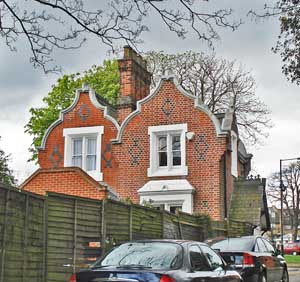
The Porter's Lodge (above and below) is the only original building to survive. It was built in the same style as the orphanage in red brick with black brick diaper patterns, with mullioned windows and curving Dutch gables. The Lodge is now No. 38 Devane Way, a private residence.
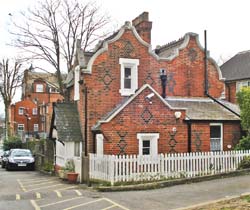
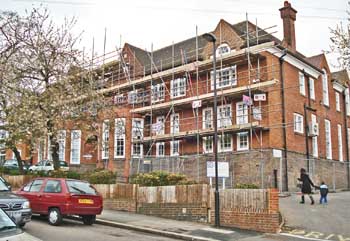
The Grade II listed Arts and Crafts-style Gabriel House (above and below) until 2012 contained offices for the London and Quadrant Housing Trust, a charitable housing trust which provides low cost social housing and short-term accommodation for homeless people.
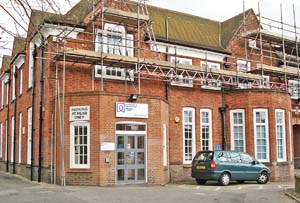
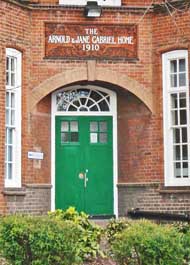
A plaque above the front door on Wolfington Road bears the legend The Arnold and Jane Gabriel Home 1910.

The rear of the U-shaped Gabriel House.
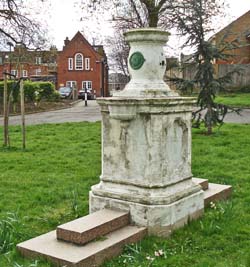
Gabriel House is seen in the background from the roundabout on Devane Way, which contains an old fountain.

Norwood Hall was on Devane Way, opposite Gabriel House, beyond the fountain.
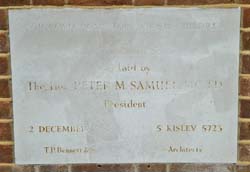
The foundation stone for the Hall was laid by Peter M. Samuel, President of the Norwood Home for Jewish Children, on 2nd December 1962.
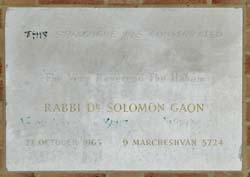
The synagogue was consecrated on 27th October 1963 by The Very Reverend The Haham Rabbi Dr Solomon Goan.
(Author unstated) 1840 Hand loom weavers. The Sessional Papers of the House of Lords 37, 247.
http://archives.ucl.ac.uk
http://cemeteryscribes.com
http://en.wikipedia.org (1)
http://en.wikipedia.org (2)
http://eprints.soton.ac.uk
http://landmark.lambeth.gov.uk
http://myweb.tiscali.co.uk
http://norwood.org
https://lambethnews.wordpress.com
www.20thcenturylondon.org.uk
www.aim25.ac.uk
www.british-history.ac.uk (1)
www.british-history.ac.uk (2)
www.britishpathe.com
www.flickr.com
www.forumancientcoins.com
www.geograph.org.uk
www.jewishencyclopedia.com
www.jewishmuseum.org.uk (1)
www.jewishmuseum.org.uk (2)
www.lambeth.gov.uk (1)
www.lambeth.gov.uk (2)
www.lengard.co.uk
www.lookandlearn.com
www.movinghere.org.uk
www.museumofcroydon.com
www.norwood.org.uk
www.norwoodsociety.co.uk
www.stgite.org.uk
www.thejc.com
www.virtualnorwood.com
Return to home page